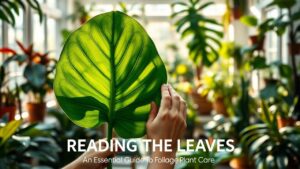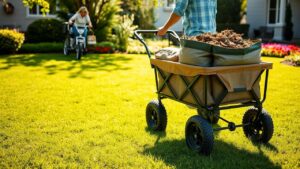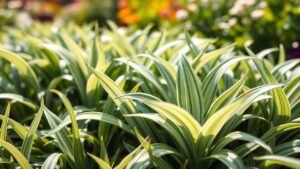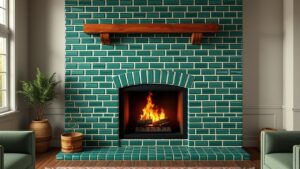Why a Dedicated Stand Is a Game-Changer for Your Indoor Garden
While it might be tempting to balance a grow light on a stack of books or hang it precariously from a nearby shelf, these makeshift solutions often do more harm than good. A dedicated grow light stand is a foundational investment that provides the stability, adjustability, and optimal light distribution essential for a thriving indoor garden. Unlike DIY setups, a proper stand eliminates the risk of lights falling and damaging your plants or creating a safety hazard.
The most critical advantage is adjustability. Plants require different light intensities at various stages of growth; seedlings, for example, need lights positioned just a few inches away to prevent them from becoming weak and “leggy,” according to Michigan State University Extension. A purpose-built stand allows you to easily raise the light source as your plants grow, maintaining the ideal distance to deliver consistent, powerful energy without scorching the leaves.
Finally, a dedicated stand ensures even light distribution. It is designed to position the light fixture directly and squarely above the plant canopy, providing uniform coverage to all parts of the plants. This prevents uneven growth where some plants stretch towards a poorly angled light source while others are left in shadow. This controlled environment sets the stage for healthier, stronger, and more productive plants.
Finding Your Fit: An Overview of Grow Light Stand Types
Choosing the right grow light stand depends entirely on your space, the number of plants you have, and your future gardening ambitions. Understanding the primary types available will help you select the perfect fit for your needs.
- Multi-Tiered Shelving Units: These are the workhorses for serious indoor gardeners or those starting a large number of seeds. These units combine storage and lighting into one efficient footprint, often featuring multiple shelves with integrated or attachable light fixtures. They are ideal for cultivating dozens of smaller plants like herbs, succulents, or seedlings in a limited space, such as a basement or spare room, as noted by Gardener’s Supply Company.
- Adjustable Tripod Stands: For gardeners with one or a few larger houseplants, a tripod stand offers incredible flexibility. These stands typically feature one or more adjustable “gooseneck” arms that can be independently positioned to illuminate plants from various angles. Their height is easily adjustable, making them perfect for taller floor plants or for providing supplemental light to a specific area of your home.
- Hanging Racks and Bars: If you plan to grow plants on a tabletop or over seed-starting trays, a simple hanging rack is an excellent choice. These typically consist of a basic frame with legs and an overhead bar from which you can hang a standard shop-style fluorescent or LED fixture. The height is usually adjusted by raising or lowering the light fixture’s chains, providing a simple and cost-effective solution for low-growing plants.
- Single-Plant Clamps: For providing a boost to a single, isolated plant on a desk or bookshelf, a clamp-on light is the most minimalist option. These fixtures have a sturdy clamp that attaches directly to a surface edge and a flexible arm to position the light precisely. While not suitable for large collections, they are perfect for keeping a prized desk plant healthy through the winter months, a solution highlighted by the Iowa State University Extension.
Your Pre-Purchase Checklist: Key Features to Consider
A grow light stand is a long-term investment in your indoor garden’s success. Before making a purchase, review this checklist to ensure the stand you choose meets the needs of both your plants and your space.
- Height and Width Adjustability: This is arguably the most crucial feature. Your stand must allow you to change the height of the light to accommodate plant growth, from tiny seedlings to mature specimens. For wider seed trays or multiple pots, width adjustability or a sufficiently wide frame is also essential to ensure all plants receive even light coverage.
- Material and Durability: Stands are typically made from metal (steel or aluminum) or plastic. Metal stands offer superior durability and stability, making them a better choice for holding heavier, multi-bulb fixtures, a point emphasized by Epic Gardening. While plastic models are lightweight and rust-proof, ensure they are made from high-quality, sturdy materials that won’t bow or become brittle over time.
- Weight Capacity: Every stand has a maximum weight it can safely support. Carefully check the manufacturer’s specifications for weight capacity, especially if you plan to use heavy fluorescent T5 fixtures or large LED panels. Overloading a stand is a significant safety risk and can lead to collapse, damaging your plants and the light itself.
- Ease of Assembly and Footprint: Consider how much space you have. A bulky, multi-tiered unit may be highly functional but might not fit in your living area. Conversely, a single tripod stand may not be efficient for a large seed-starting project. Look at the product’s dimensions and read reviews regarding the ease of assembly—a stand that is difficult to put together or take down may become a source of frustration.
Optimal Setup: Positioning Your Stand for Maximum Plant Growth
Once you’ve chosen your grow light stand, proper setup is key to unlocking its full potential. A strategic approach to placement and adjustment will ensure your plants receive the energy they need to flourish.
First, position the stand in a suitable location. Choose a spot near a dedicated electrical outlet to avoid using long, hazardous extension cords. Keep the setup away from high-traffic areas to prevent it from being knocked over and clear of drapes or other flammable materials. Also, be mindful of temperature; avoid placing plants directly next to a drafty window or a hot radiator, as extreme temperature fluctuations can cause stress.
Next, focus on the most critical adjustment: the light-to-plant distance. This distance varies based on the type of light and the plant’s growth stage. The University of Minnesota Extension provides helpful guidelines:
- For Seedlings: Position LED or fluorescent lights just 2-4 inches above the seedlings to prevent them from becoming tall and weak.
- For Mature Plants & Foliage Growth: A distance of 12-24 inches is generally effective for most mature houseplants under standard LED lights.
Always check the manufacturer’s recommendation for your specific light fixture, as intensity varies. Monitor your plants closely; if you see white or yellowed spots on the leaves, the light may be too close and causing scorching.
Finally, practice good cord management. Bundle and secure any loose wires to the stand’s frame using zip ties or hook-and-loop straps. This creates a clean, organized look and, more importantly, prevents tripping hazards and reduces the risk of accidentally unplugging or pulling down your lighting system.
Common Mistakes to Avoid for Long-Term Success
Using a grow light stand can dramatically improve your indoor gardening results, but a few common mistakes can undermine your efforts. Avoiding these pitfalls will help ensure your plants remain healthy and productive for the long term.
One of the most frequent errors is choosing a stand that is too small. Gardeners often purchase a stand that fits their current plant collection perfectly, failing to account for future growth or new plant acquisitions. A plant can quickly outgrow the maximum height of a short stand, and a narrow frame will not provide adequate light coverage as plants become wider. Always opt for a stand with more height adjustability than you think you currently need.
Another mistake is failing to provide a consistent light schedule. Plants thrive on routine. As Penn State Extension explains, leaving grow lights on 24/7 can disrupt their natural respiration cycle, while an erratic schedule provides inconsistent energy. The best practice is to connect your light to an automatic timer, ensuring your plants receive a consistent 14 to 16 hours of light per day, mimicking a natural summer day.
Finally, don’t ignore the physical limitations of the stand itself. Overloading a shelf with too many heavy, water-logged pots can exceed its weight capacity, leading to bowing or collapse. Similarly, placing a tall, top-heavy stand on an uneven surface can create instability. Always respect the manufacturer’s guidelines for weight and ensure the stand is placed on a level, stable floor to prevent accidents and protect your botanical investment.





